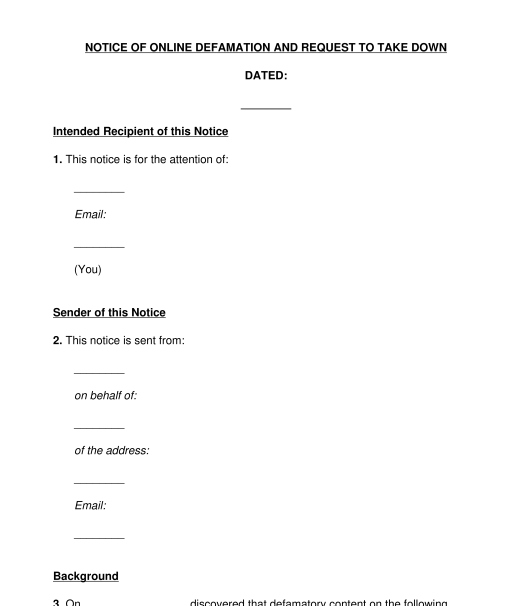 18/10/2025
18/10/2025

Answer a few questions and your document is created automatically.

Your document is ready! You will receive it in Word and PDF formats. You will be able to modify it.

 18/10/2025
18/10/2025
 Word and PDF
Word and PDF
 6 to 7 pages
6 to 7 pages
This document is a website defamation notice which can be used by individuals or businesses to make a request to the owner of a website/host of the online platform (a website operator) to remove defamatory content posted by a user of the website. The document can be used where the claim for defamation is applicable within the jurisdiction of England and Wales.
Circumstances where a website defamation notice may be appropriate
This document is designed for use where it has not been possible to identify the individual website user who has been responsible for posting defamatory content. In those circumstances, it can be useful to send this notice to the website operator in order to request that the material is removed from the website.
Online platforms may only become liable for any content it is hosting that infringes defamation laws where it has received proper notice of the same. Furthermore, it would only be appropriate to obtain court remedies (such as an injunction) when an online platform has knowledge of the content. This notice, therefore:
A person or business may therefore wish to send a defamation to a website operator where:
If the sender knows the identity and the contact details of the person responsible for the post and has sufficient information to provide that person with a formal warning/bring proceedings against them, then this document should not be used. In those circumstances, the matter should be raised with the person who has made the statement directly.
Definition of defamation
A defamatory statement is a statement which has an adverse impact on the reputation of an individual. In the case of content which is posted online, this will fall under the category of libel which is a form of defamation.
In order to be considered defamatory, it is necessary to show that the statement has caused or is likely to cause serious harm to the reputation of the person concerned.
A defendant to any defamation action may be able to raise a defence in any subsequent legal proceedings. Two important defences may be raised where it can be made out that the statement was:
(a) factually true; or
(b) that the statement was an honestly held opinion which was based on facts known at the time.
Contents of the notice
It is therefore important to address the above factors within the defamation notice, to explain to the website operator why the particulars of defamation are made out.
There are also other specific factors which must, by law, be addressed within a defamation notice. The questionnaire within the document will ask each of those points so that they may be addressed within the notice.
This document should be completed with all the relevant factual information relating to the defamatory statements. In cases where multiple defamatory statements were made by the same user on the website, then this document allows for up to 5 separate defamatory statements to be included.
It is very important that the notice is completed accurately and in full with all the relevant information. If any information is missing, the notice might be considered invalid and the website may not process the request.
Following completion of the document, the sender may electronically sign the document and send it by email to the website operator's email address. It is useful to request a delivery receipt, in case proof of delivery of the email is required in the future. If the website operator's postal address is known, the document may also be printed, signed and sent by registered mail to the website operator. In those circumstances, it is important to keep the relevant proof of delivery.
Upon the website operator's receipt of the notice, they have certain legal obligations which they must comply with:
If the website operator does not comply with the full process outlined above, then the sender may wish to issue proceedings against the website operator directly.
The Defamation Act 2013
The Defamation (Operators of Websites) Regulations 2013
Regulation 19 of the E-Commerce Regulations (SI 2002/2013)
The Ministry of Justice published a very useful guide entitled Complaints about Defamatory material posted on Websites: Guidance on Section 5 of the Defamation Act 2013 and Regulations
You fill out a form. The document is created before your eyes as you respond to the questions.
At the end, you receive it in Word and PDF formats. You can modify it and reuse it.
Website Defamation Notice - Template - Word & PDF
Country: United Kingdom